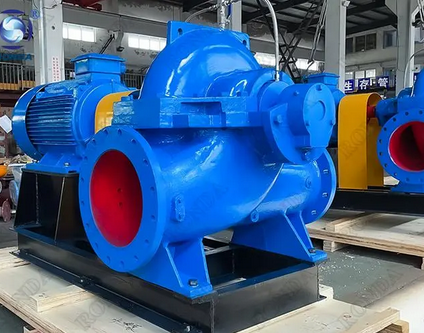Selection rules for large flow double suction pumps
The selection rules for large-flow double-suction pumps are a process that takes into account multiple factors to ensure that the selected pump can meet the performance requirements of specific applications while maximizing economy and reliability. The following are the main rules for selecting large-flow double-suction pumps:
1. Clear requirements
Flow requirements: Determine the required maximum, normal and minimum flow ranges. Usually in cubic meters per hour (m³/h) or liters per second (L/s). If the customer has given specific flow data, the maximum flow should be given priority, and a certain margin should be reserved to cope with fluctuations.
Lift requirements: Clarify the total energy loss that the liquid needs to overcome from the inlet to the outlet, that is, the lift. Determine the required lift range based on working conditions and conveying distance, usually in meters (m). The lift range of large-flow double-suction pumps is generally between 8m and 200m.
Liquid properties: Understand the physical and chemical properties of the conveyed liquid, such as density, viscosity, temperature, corrosiveness, solid particle content, etc. These parameters will directly affect the material selection, sealing form and service life of the pump.
Installation conditions: Consider the installation position, height, length, diameter and layout of the suction and discharge pipes of the pump. These factors will affect the actual head and performance of the pump.
2. Select the pump type
Structural type: Double suction pumps can be divided into two structures: horizontal and vertical. Horizontal double suction pumps are compact and easy to maintain; vertical double suction pumps occupy a small area and are suitable for occasions with limited space. Select the appropriate structural type according to the specific installation conditions and space requirements.
Model selection: According to performance parameters such as flow rate and head, refer to the pump performance curve and the data sheet provided by the manufacturer to select a double suction pump model that can meet the requirements. At the same time, consider the performance indicators such as pump efficiency, cavitation margin, noise and vibration.
Material selection: According to the properties of the conveyed liquid and working conditions such as temperature and pressure, select appropriate pump materials. For corrosive liquids, corrosion-resistant materials should be selected; for high-temperature liquids, high-temperature resistant materials should be selected.
3. Economy and reliability
Economy: Comprehensively consider factors such as pump price, performance, operating cost and maintenance costs. Choose a pump type with high cost performance to reduce the overall investment cost.
Reliability: Choose a pump manufacturer with reliable quality and good after-sales service. Understand the manufacturer's qualification certification, technical strength and market reputation to ensure that the selected pump type can operate stably and reduce the failure rate during use.
4. Other considerations
Reserve margin: When selecting a pump type, a certain amount of flow and head margin should be reserved to cope with fluctuations and changes in actual operation. This helps to ensure that the pump operates within the high-efficiency range and prolongs its service life.
Consider safety factors: When selecting a pump type, safety factors such as explosion-proof and fire-proof requirements should also be considered to ensure safety during the production process.
Consult professionals: If you have any questions or uncertainties during the selection process, you can consult professional engineers or pump manufacturer technicians to obtain more accurate advice and guidance.





